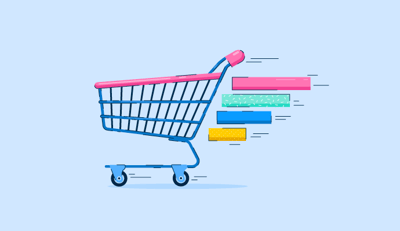October 1, 2025
 by Sagar Joshi / October 1, 2025
by Sagar Joshi / October 1, 2025

We get it. Selling online isn’t just about having a great product anymore. People don’t always buy the “best” thing on the shelf; they buy the one they feel most connected to. Because that’s how we shop now: we see, we like, we trust and then we buy.
But building that trust through static product pages, promo emails, paid ads and social media posts ? It’s getting harder by the day. Shoppers want to see products in action, ask questions in real time, and hear from someone they relate to before they hit “checkout.”
That’s where live commerce flips the script.
Live commerce combines livestreaming with online shopping, allowing viewers to watch product demonstrations in real time and make purchases instantly. It builds trust through direct interaction, drives engagement, and increases conversion rates. Popular on platforms like TikTok and Instagram, live commerce is widely used in beauty, fashion, and tech.
Live commerce requires integrating video shopping tools, live chat, and shopping cart platforms to ensure a smooth user experience during live streams.
Since live streams mostly happen on social media, the line between live commerce and social commerce is getting increasingly blurry. Social network platforms like Facebook and TikTok now offer Facebook Live and TikTok Live, making it easy for e-commerce businesses to reach viewers through live streams. But it all started with Taobao Live.
Read on to learn about how it started, what its benefits are, and how you can create live commerce campaigns for your brand.
Before we started talking about livestream shopping and TikTok sales, there was teleshopping. Remember QVC and HSN? Viewers tuned in to watch enthusiastic hosts demo products live on TV, and many would pick up the phone and order on the spot. That mix of entertainment, storytelling, and instant buying power was the earliest version of what we now call live commerce.
Fast forward a few decades, and the same idea has been reimagined for the social media era. Instead of television studios, brands go live from their phones. Instead of passive viewers, they’re talking to real customers who can ask questions, drop comments, and buy with a single click — all without leaving the stream.
The modern version of live commerce really took off in 2016, when Alibaba launched Taobao Live, combining livestreaming with e-commerce in a way no one had done before. It changed everything.
The Chinese retail giant Alibaba introduced livestreaming e-commerce with Taobao Live in 2016. They combined an online livestream broadcast with an e-commerce store to let users watch the stream and shop simultaneously.
Since then, live commerce has become a vital part of sales campaigns in China, especially during Singles’ Day, one of the country’s biggest shopping events. In 2020, Taobao Live hit $7.5 billion in transactions within the first 30 minutes of the Singles’ Day presales campaign going live – a 400% jump from the previous year.
Western brands and retailers jumped on the live commerce trend, too. Early adopters included German beauty retailers Douglas, Tommy Hilfiger, and Walmart.
The live-stream shopping market in the U.S. is expected to hit $35 billion by 2024. Meanwhile, the European live commerce market is growing at a rapid CAGR of 26.8%, with luxury and fashion brands using live streaming to offer exclusive previews, product launches, and behind-the-scenes content. The Asia-Pacific region led the live commerce platform market share in 2023, grabbing over 40% of the total revenue.
Live commernce is a response to how people actually shop now. Short-form video has reshaped attention spans. Social algorithms prioritize interaction over promotion. And with paid ads and acquisition costs higher than ever, every product page now has to work harder, capturing attention, sparking interaction, and guiding shoppers toward a purchase.
Live commerce transforms your storefront into a two-way conversation: one that fosters trust, shortens the path to purchase, and drives conversions in real-time.
For marketers, the value goes beyond revenue. It’s a chance to collect real-time feedback, test messaging, launch products with instant validation, and create moments that social algorithms love to amplify. And with live shopping projected to account for 10% to 20% of all e-commerce sales by 2026, it’s quickly moving from “nice-to-have” to “non-negotiable.”
For customers, they see products in action, ask questions in real time, get personalized recommendations, and become more confident in their purchase decisions. Add in the excitement of limited-time deals and exclusive offers, and you’ve got a recipe for higher engagement, trust, and repeat business.
E-commerce marketers use four types of live commerce, including:
Online marketplaces like Alibaba, eBay, and Amazon integrate live video shopping into their e-commerce platforms by making it part of their marketplace experience. This integration makes it easy for sellers to reach more customers and showcase their products.
For example, Amazon Live Commerce lets sellers and influencers host live streams to show off product features. The purchase options right next to the video make shopping easier for customers.
B2C e-commerce brands, especially in beauty and skin care, use live product demos to show customers how to use products and cross-sell related items. These tutorials add value to the viewer’s time by sharing valuable tips and tricks.
Live events and FAQs are another way businesses use live streaming commerce to spread the word about their products and build awareness. These video broadcasts let brands answer customer questions directly, which helps boost brand recall. Businesses can also use live events to launch new products and offer training sessions or workshops.
Live auctions are a popular live commerce format in which viewers can participate in real-time bidding while enjoying the convenience of online shopping. Hosts showcase products during a live stream, and customers can ask questions before bidding.
Live commerce can work across industries, but it’s especially powerful for products that need to be shown, explained, or experienced to sell. Brands in these sectors tend to see the highest ROI:
If your product benefits from demonstration or storytelling, live commerce isn’t just a good fit; it’s a growth channel.
Launching a live commerce campaign isn’t just about hitting “Go Live.” The most successful brands treat it like a well-planned event, blending storytelling, interactivity, and seamless shopping to move customers from curiosity to checkout in real time. Here’s how to do it right:
Every decision, from content style to platform choice, depends on why you’re running the campaign. Are you:
Not all live commerce happens in the same place:
If you’re starting out, go where your audience already spends time and then experiment with other formats as you scale.
Before you launch, check out G2’s live commerce software category, where you can evaluate leading platforms based on features, pricing, and verified user feedback to choose the right fit for your campaign.
The most effective live commerce campaigns are structured and dynamic. Plan your content in segments like product reveals, demos, Q&A, behind-the-scenes moments, and exclusive offers.
Your host is the face of the experience and often the difference between viewers tuning out or sticking around. They should be confident, personable, and able to improvise as questions and comments come in. The goal isn’t to read a script; it’s to make the audience feel like they’re part of a real conversation.
Influencers can be a powerful choice here. Their built-in credibility and existing audience trust can dramatically boost visibility and engagement, especially for brand awareness campaigns or new product launches. But they’re not the only option. Internal team members, product experts, or charismatic brand ambassadors can be just as effective if they know the product inside-out and can connect authentically with viewers.
A successful campaign starts long before showtime. Here’s how to do it effectively:
This pre-launch buzz not only drives viewership but also signals urgency and primes your audience to buy before the event even starts.
Engagement is what sets live commerce apart from traditional e-commerce. Prompt viewers to:
Every interaction deepens trust and keeps people watching. Layer in time-sensitive offers or “live-only” bundles to turn attention into action.
Even the most engaging livestream can lose sales if the buying process is slow or complicated. In live commerce, every extra click is a chance for viewers to drop off, so your goal is to make purchasing feel like a natural part of the experience, not a separate step. Here’s how to do it:
When buying is effortless, the moment of interest becomes the moment of purchase and that’s where live commerce delivers its biggest ROI.
Your live stream doesn’t end when the camera turns off. Repurpose clips into ads, social posts, or email content. Follow up with attendees using personalized recommendations or exclusive offers.
Review performance data. Look for watch time, drop-off points, and conversion spikes to refine future campaigns.
Let’s look at real-life examples of brands taking live commerce to the next level.
The popular American luxury department store chain has a dedicated live shopping channel to host shopping events like Spring beauty trends and dressing for special occasions.
Source: Nordstrom
Using a dynamic format like live video shopping allows Nordstrom to offer customers an interactive experience and allow them to shop for products at the same time.
The South Korean appliance and consumer electronics company uses live commerce apps to deliver live and recorded shopping experiences.
Source: Samsung
Their live shopping platform keeps you in the loop with upcoming live stream schedules, exclusive events, and great deals. Plus, you can chat with the host through a chat bar—just like talking to a shopkeeper in a physical store.
This American cosmetics retailer hosts virtual events where skin specialists share tips, tricks, and product recommendations with the audience.
Source: Kiehl’s
Having skin experts host their live streams helps build trust with their audience. Plus, each stream highlights featured products with discounts, making it perfect for customers to make impulse purchases.
Adopting live commerce allows brands, retailers, and e-commerce companies to gain a competitive edge. Here’s how:
Live shopping events are entertaining and interactive, so your customers stick around longer. The longer they watch, the faster you can move them from being aware of your product to buying it. Use time-limited tactics like exclusive discounts or one-time coupons, which can push customers to impulse buying.
Some companies using live commerce have seen conversion rates up to ten times higher than regular online shopping.
Brands adding live commerce to their omnichannel strategy can quickly grab the attention of Millennials and Gen Z. These younger shoppers love innovative, interactive shopping formats—especially when they get advice or see products from trusted influencers.
Plus, live streaming brings a sense of community, where they can watch, comment, and shop together in real time. These factors can help your brand stand out and attract new customers.
Live video shopping lets your customers see more than just a product—they get the story behind it, live demos, and even testimonials from other buyers. They can also ask questions, making it a two-way conversation that builds trust and keeps them returning.
Livestreams are a goldmine for audience insights – you can learn a lot from your customers’ comments, reactions, and questions. Plus, you can answer questions on the spot, helping them feel more confident about their purchases.
Live commerce uses live streaming apps to offer real-time interactive shopping, while social commerce involves selling directly on social media platforms without live interaction.
Live commerce relies on live video streams to let customers interact with hosts and influencers, ask questions, and make purchases. The real-time connection is vital: it gets viewers involved, helps them learn about product benefits, and addresses doubts instantly.
This kind of interaction builds trust between the brand and the customer. Live commerce boosts conversion rates with flash sales, exclusive discounts, and limited-time offers.
Social commerce uses ads, posts, or in-app stores on social media to promote and sell products. It builds trust through reviews and user-generated content. What sets social commerce apart from live commerce is its ability to create a virtual word-of-mouth effect, where users share their experiences and recommend products to their network.
|
Live commerce |
Social commerce |
|
|
Target audience |
Customers seeking interactive, personalized shopping experiences |
Customers looking for convenient, casual shopping experiences |
|
Interaction |
Real-time interaction between customers and hosts |
Lacks interactions, transactions happen via posts or ads |
|
Engagement |
High, due to live Q&A, demos, and urgency |
Moderate, based on likes, comments, and shares |
|
Urgency factor |
Creates urgency with time-sensitive deals and limited product availability |
Lacks time-bound urgency |
|
Best for |
Beauty, fashion, electronics, and luxury products that need demos and real-time interaction |
Lifestyle, home decor, and everyday products that require customer reviews and recommendations |
The following best practices go beyond the basics to help you design campaigns that keep viewers hooked, drive conversions, and build lasting customer loyalty.
Let’s combat some of the biggest myths around live commerce.
The live commerce landscape continues to evolve, and staying ahead of these trends will help you maximize your campaigns:
China embraced live selling early with platforms like Taobao Live, where influencer-led streams, interactive shopping, and built-in checkout made it a mainstream e-commerce channel. Cultural factors also play a role: Chinese consumers value interactive, influencer-led shopping experiences, and brands have embraced live selling as a mainstream sales channel. As a result, China now accounts for the majority of global live commerce revenue and regularly drives billions in sales during events like Singles’ Day.
It depends on your goals: TikTok Live and Instagram Live are best for reach and engagement, Amazon Live and Taobao Live for conversions. On-site tools offer more control. Check G2’s live commerce category to compare options.
Social commerce is selling products directly on social media platforms, o ften through posts, ads, or in-app stores, without necessarily involving real-time interaction.
Live commerce, on the other hand, is interactive and event-driven. It uses livestreaming to connect with shoppers in real time, demonstrate products, answer questions, and create urgency with time-sensitive deals.
QVC and other traditional teleshopping networks were early versions of live commerce but lacked real-time viewer interaction. Live commerce builds on that model by adding two-way communication, instant feedback, and integrated checkout, turning a one-way broadcast into a conversation that feels more social, personalized, and engaging.
Beauty, fashion, consumer electronics, home goods, and luxury products perform best because they benefit from demos and real-time explanations.
Yes. Live commerce boosts engagement, builds trust, and increases conversions and it’s expected to account for 10–20% of all e-commerce sales by 2026.
Live commerce might be the perfect strategy this year if you’re struggling to create urgency, boost engagement, or build customer trust. Live video commerce lets you connect with customers in real time and makes shopping fun for them.
You can increase conversions with discounts, freebies, and limited-time deals while easily cross-selling complementary products. Plus, it’s a great way to learn about your customers’ concerns as they ask questions and share feedback.
Thinking about hosting influencers in your live sessions? Learn how influencer marketing works and how to get started.
Edited by Monishka Agrawal
This article was published in 2024 and has been updated with new information.
Sagar Joshi is a former content marketing specialist at G2 in India. He is an engineer with a keen interest in data analytics and cybersecurity. He writes about topics related to them. You can find him reading books, learning a new language, or playing pool in his free time.
E-commerce is the process of buying and selling products and services online. Customers use...
 by Sagar Joshi
by Sagar Joshi
You don’t need me to tell you mobile phones are everywhere. You may be reading this on your...
 by Lauren Fram
by Lauren Fram
Whether you're selling fashion accessories, upscale electronics, or consumer packaged goods,...
 by Leigh-Anne Truitt
by Leigh-Anne Truitt
E-commerce is the process of buying and selling products and services online. Customers use...
 by Sagar Joshi
by Sagar Joshi
You don’t need me to tell you mobile phones are everywhere. You may be reading this on your...
 by Lauren Fram
by Lauren Fram


